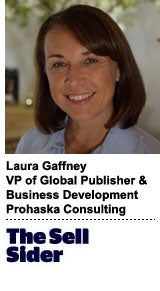“The Sell Sider” is a column written by the sell side of the digital media community.
Today’s column is written by Laura Gaffney, vice president of global publisher and business development at Prohaska Consulting.
When the fit is right, the relationship between publisher and ad tech developer can create a powerful synergy. The benefits are abundantly clear, as I have seen in my work on both sides of the publisher-ad tech equation.
In today’s increasingly crowded market place, the right connection can be hard to find. Too often, when it comes to the sales cycle, ad tech companies put enormous emphasis on their product’s technical capabilities, yet fail to establish a solid business case by articulating the value proposition that will resonate with the publisher.
So what can publishers do to cut quickly through the tech speak and gear up for the most productive conversation? How can you be sure that when you pick up the phone for a cold call or compile an initial list of companies to reach out to that you are talking to the right people? You don’t want to waste anybody’s time, and certainly not your own.
I see three factors that can make the difference in creating a successful publisher and ad tech vendor dynamic: effective communication, clear product differentiation and value mapping.
Setting Expectations
A publisher’s key priorities are audience, content, user experience and revenue. Ad tech companies need to take a deep dive into which problem(s) their solution addresses. Their marketing messaging and sales strategy should articulate the product benefits with publisher-specific priorities (and ROI) top of mind.
Publishers should expect any potential vendor to have done their (math) homework. If the vendor is saying that their solution will increase revenue, they should come prepped with the numbers. That takes work and detailed background knowledge. But even if the numbers aren’t being run specifically for a publisher’s site, they should at least reflect the category in which it operates.
Publishers should also expect the vendor to tailor their sales messaging to their specific requirements. Publishers are busy. Beyond knowing how a vendor’s “unique technology capabilities” might affect its site performance or user experience, publishers don’t have the time for a deep tech dive. A good vendor will talk the language publishers understand. The pitch should be less about the tech creds of the solution and more about how the solution will benefit the publisher.
If vendors don’t hit that mark right out of the gate, it should give publishers pause for thought.
Standing Out From The Crowd
Ten years ago, when I was selling an in-text solution to publishers, it was easy to get a response; I could just pick up the phone and talk to a publisher. Today publishers can get an average of 10 to 12 outreaches a day.
It’s a crowded marketplace. The advent of cloud-based solutions, such as AWS, has lowered the barrier to entry into the world of ad tech. Increased competition and the plethora of solutions available today can leave publishers overwhelmed; it is increasingly difficult for them to distinguish between one company’s tech advantages versus another.
So publishers need to do their homework, too, or they could end up buried trying to find the right product for their needs. It all starts with knowing their goals. Ahead of a meeting, publishers should give vendors a needs analysis and help them understand their limitations, too. Publishers should also tell them about company policies, such as no-way autoplay, that will help them better tailor their solution to fit the site.
The Power Of Value Mapping
If vendors take the time upfront to perform critical value-mapping exercises, they may be worth a second look.
Value mapping need not be a resource-intensive exercise, but it must be an iterative process throughout the product life cycle. If vendors could get the right people in the room and think about the product from the publisher’s point of view, it could make all the difference in not just creating a great product, but in selling it to publishers most effectively.
When publishers are approached in a consultative manner and get to express what is important to them, a value proposition can be clearly articulated and a match made. This paves the way for a successful partnership and not just a transactional, low-value sale.
In the SaaS model, this is referred to as customer success, which reduces churn and creates long-term value. These strategic partnerships can create lasting value for everyone in the ecosystem – the vendor, the publisher, the consumer and investors.
Follow Prohaska Consulting (@TeamProhaska) and AdExchanger (@adexchanger) on Twitter.














